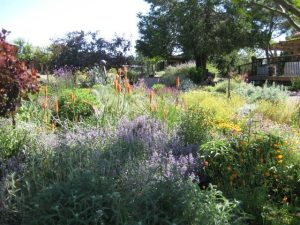I’m a transplanted gardener from Southern California. I didn’t know what frost warnings were. There, I bought plants or seeds and put them in the soil and they grew. Imagine my surprise when I unexpectedly moved to Northern California in November four years ago and it snowed several times over the next six months. Not only did I not want to venture outside, I had not even a remote idea what I could plant that would grow.
My new garden journey started by reading. I didn’t understand the questions, much less the answers! What zone and elevation am I gardening in? What’s my first and last frost date? How many growing days do I have? All of these questions helped answer “what’s my gardening happy spot?”
The first question to answer is that of elevation, a factor that influences temperature and precipitation. Search for this information on-line. Next, find your USDA (United States Department of Agriculture) hardiness zone by zip code. It’s seen as an assigned number or color on a map. Here in Sonora we are in USDA hardiness zone 9a.
The continental United States includes Zones 3-11; California zones range from 4-11. Growing zones are based on average annual minimum winter temperatures. Colder zones have lower numbers; higher numbered zones are warmer. For example, zone 5 is 10 degrees colder than zone 6. Zones are further divided into “a” and “b” gradations, which have five-degree increments.
This year I really experienced climate zones firsthand. I went garden browsing to look at local blooms. The very next weekend I went to the Bay Area and, right in front of my eyes, the same flower types were past their optimal blooms. It was a different zone (actually two different zones), so 20 degrees difference resulted in Bay Area flowers blooming weeks ahead of the foothills. It was a revelation to me – an epiphany bringing home the reality of gardening in my specific happy spot.
As beginning gardeners, we need to look at our potential garden site and make sure the area has adequate sunshine, ideally 6-8 hours of sun for most vegetables, and access to water and soil. (The soil can be in containers if only a patio area is available.) Plant after the last frost date in spring listed on the plant tag or seed packet. Vegetables will also list the number of days needed to achieve ripening, which needs to be before the first frost date in autumn. Nursery seedling labels will provide this information as well. You can plant seeds directly in the ground or start seedlings in a greenhouse to transplant at the correct time for your USDA zone.
Many states have multiple hardiness zones influenced by elevation, latitude, rainfall and topography. Even within your yard there are microclimates with small temperature variations that favor individual plants. Make notes from year to year, enjoy your garden – whatever type or size you have – and may we all find our happy spot.
Diane Miller is a University of California Cooperative Extension Master Gardener of Tuolumne County.

